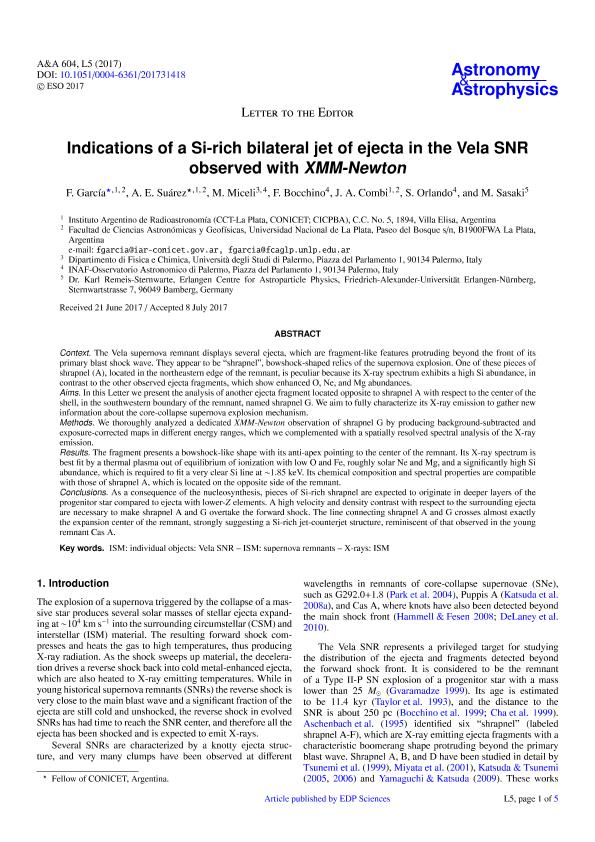Mostrar el registro sencillo del ítem
dc.contributor.author
García, Federico

dc.contributor.author
Suárez, Alejandra Etelvina

dc.contributor.author
Miceli, M.
dc.contributor.author
Bocchino, F.
dc.contributor.author
Combi, Jorge Ariel

dc.contributor.author
Orlando, S.
dc.contributor.author
Sasaki, M.
dc.date.available
2018-02-01T12:51:32Z
dc.date.issued
2017-08
dc.identifier.citation
García, Federico; Suárez, Alejandra Etelvina; Miceli, M.; Bocchino, F.; Combi, Jorge Ariel; et al.; Indications of a Si-rich bilateral jet of ejecta in the Vela SNR observed with XMM-Newton; EDP Sciences; Astronomy and Astrophysics; 604; 5; 8-2017; L5-L10
dc.identifier.issn
0004-6361
dc.identifier.uri
http://hdl.handle.net/11336/35344
dc.description.abstract
Context. The Vela supernova remnant displays several ejecta, which are fragment-like features protruding beyond the front of its primary blast shock wave. They appear to be "shrapnel", bowshock-shaped relics of the supernova explosion. One of these pieces of shrapnel (A), located in the northeastern edge of the remnant, is peculiar because its X-ray spectrum exhibits a high Si abundance, in contrast to the other observed ejecta fragments, which show enhanced O, Ne, and Mg abundances. Aims. In this Letter we present the analysis of another ejecta fragment located opposite to shrapnel A with respect to the center of the shell, in the southwestern boundary of the remnant, named shrapnel G. We aim to fully characterize its X-ray emission to gather new information about the core-collapse supernova explosion mechanism. Methods. We thoroughly analyzed a dedicated XMM-Newton observation of shrapnel G by producing background-subtracted and exposure-corrected maps in different energy ranges, which we complemented with a spatially resolved spectral analysis of the X-ray emission. Results. The fragment presents a bowshock-like shape with its anti-apex pointing to the center of the remnant. Its X-ray spectrum is best fit by a thermal plasma out of equilibrium of ionization with low O and Fe, roughly solar Ne and Mg, and a significantly high Si abundance, which is required to fit a very clear Si line at ∼1.85 keV. Its chemical composition and spectral properties are compatible with those of shrapnel A, which is located on the opposite side of the remnant. Conclusions. As a consequence of the nucleosynthesis, pieces of Si-rich shrapnel are expected to originate in deeper layers of the progenitor star compared to ejecta with lower-Z elements. A high velocity and density contrast with respect to the surrounding ejecta are necessary to make shrapnel A and G overtake the forward shock. The line connecting shrapnel A and G crosses almost exactly the expansion center of the remnant, strongly suggesting a Si-rich jet-counterjet structure, reminiscent of that observed in the young remnant Cas A.
dc.format
application/pdf
dc.language.iso
eng
dc.publisher
EDP Sciences

dc.rights
info:eu-repo/semantics/openAccess
dc.rights.uri
https://creativecommons.org/licenses/by-nc-sa/2.5/ar/
dc.subject
Vela Snr
dc.subject
Supernova Remnants
dc.subject
X Rays
dc.subject
Insterstellar Medium
dc.subject.classification
Astronomía

dc.subject.classification
Ciencias Físicas

dc.subject.classification
CIENCIAS NATURALES Y EXACTAS

dc.title
Indications of a Si-rich bilateral jet of ejecta in the Vela SNR observed with XMM-Newton
dc.type
info:eu-repo/semantics/article
dc.type
info:ar-repo/semantics/artículo
dc.type
info:eu-repo/semantics/publishedVersion
dc.date.updated
2018-01-12T19:27:21Z
dc.journal.volume
604
dc.journal.number
5
dc.journal.pagination
L5-L10
dc.journal.pais
Francia

dc.description.fil
Fil: García, Federico. Provincia de Buenos Aires. Gobernación. Comisión de Investigaciones Científicas. Instituto Argentino de Radioastronomía. Consejo Nacional de Investigaciones Científicas y Técnicas. Centro Científico Tecnológico Conicet - La Plata. Instituto Argentino de Radioastronomía; Argentina. Universidad Nacional de la Plata. Facultad de Ciencias Astronómicas y Geofísicas; Argentina
dc.description.fil
Fil: Suárez, Alejandra Etelvina. Provincia de Buenos Aires. Gobernación. Comisión de Investigaciones Científicas. Instituto Argentino de Radioastronomía. Consejo Nacional de Investigaciones Científicas y Técnicas. Centro Científico Tecnológico Conicet - La Plata. Instituto Argentino de Radioastronomía; Argentina. Universidad Nacional de la Plata. Facultad de Ciencias Astronómicas y Geofísicas; Argentina
dc.description.fil
Fil: Miceli, M.. Università degli Studi di Palermo; Italia
dc.description.fil
Fil: Bocchino, F.. Università degli Studi di Palermo; Italia
dc.description.fil
Fil: Combi, Jorge Ariel. Provincia de Buenos Aires. Gobernación. Comisión de Investigaciones Científicas. Instituto Argentino de Radioastronomía. Consejo Nacional de Investigaciones Científicas y Técnicas. Centro Científico Tecnológico Conicet - La Plata. Instituto Argentino de Radioastronomía; Argentina. Universidad Nacional de la Plata. Facultad de Ciencias Astronómicas y Geofísicas; Argentina
dc.description.fil
Fil: Orlando, S.. Universita Degli Studi Di Palermo; Italia
dc.description.fil
Fil: Sasaki, M.. Friedrich-Alexander-Universität Erlangen-Nürnberg; Alemania
dc.journal.title
Astronomy and Astrophysics

dc.relation.alternativeid
info:eu-repo/semantics/altIdentifier/doi/http://dx.doi.org/10.1051/0004-6361/201731418
dc.relation.alternativeid
info:eu-repo/semantics/altIdentifier/url/http://www.aanda.org/10.1051/0004-6361/201731418
Archivos asociados
